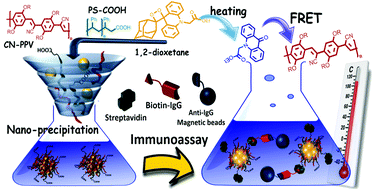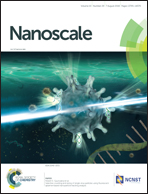Thermochemiluminescent semiconducting polymer dots as sensitive nanoprobes for reagentless immunoassay†
Abstract
Thermochemiluminescence (TCL) is a potentially simple and sensitive detection principle, as the light emission is simply elicited by thermally-triggered decomposition of a molecule to produce a singlet excited-state product. Here we report about TCL semiconductive polymer dots (TCL-Pdots) obtained by doping fluorescent cyano-polyphenylene vinylene (CN-PPV) Pdots with an acridine 1,2-dioxetane derivative. The TCL-Pdots showed remarkable stability over time and minimum leaching of the thermo-responsive species. Furthermore, detectability of TCL-Pdots was improved by taking advantage of both the high number of 1,2-dioxetanes entrapped in each nanoparticle (about 20 molecules per Pdot) and the 5-fold enhancement of TCL emission due to energy transfer from 1,2-dioxetane to the polymer matrix, which itself acted as an energy acceptor. Indeed, upon heating the TCL-Pdots to 110 °C, 1,2-dioxetane decomposes generating an acridanone product in its electronically excited state. The latter transfers its energy to the surrounding CN-PPV chains via the Förster mechanism (ϕFRET about 80%), resulting in intense yellow light emission (550 nm wavelength). We next conjugated streptavidin onto the surface of these TCL-Pdots and demonstrated their suitability for use in biological studies. In particular, we used TCL-Pdots as labels in a model non-competitive immunoassay for IgG detection, which showed a LOD of 13 nM IgG and a dynamic range extending up to 230 nM. By combining the biocompatibility, brightness and tunability of Pdot fluorescence emission with the thermally-triggered reagentless light generation from TCL 1,2-dioxetanes, a broad panel of ultrabright TCL nanosystems could be designed for a variety of bioscience applications, even in multiplexed formats.



 Please wait while we load your content...
Please wait while we load your content...